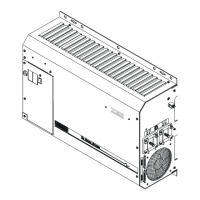OPERATION
Page
86
Copyright Trace Engineering Company, Inc.
5916 - 195th Street N.E.
Arlington, WA 98223
Telephone: 360/435-8826
Fax: 360/435-2229
www.traceengineering.com
PS Series Inverter/Charger
Part No. 3597
Rev. D: November 23, 1999
A system that includes 2400 watts of solar array is able to produce approximately 18 amps of AC power
at 120 VAC. The output is most needed from 12:00 noon to 18:00 by the utility. If the GRID USAGE
TIMER is set to a START CHARGE TIME of 18:00 and a END CHARGE TIME of 12:00 noon, the
inverter will sell the battery from 12:00 noon to 18:00. The energy in the batteries will be used only if the
solar array is not able to provide enough power to reach the 18 amps AC (determined by the MAX SELL
AMPS AC setting under the BATTERY SELLING (17) menu heading. The battery will assist the solar
array to meet the 18 amps AC MAX SELL AMPS AC setting during the battery sell period. If the battery
reaches the SELL VOLTS DC setting during the sell period, the AC output current will slowly taper down
to the solar array’s output level and the battery will not be further discharged. At 18:00, the battery will
charge at the rate allowed by the SET MAX CHARGE AMPS AC (2 amps AC is the lowest setting
allowed). The battery will be recharged only to the FLOAT VOLTS DC setting unless the BULK CHARGE
TRIGGER TIMER (15) menu heading is used to trigger a bulk charge cycle.
This system offers the utility several advantages. The system can be relied on for a specific amount of
output at a set time. The AC output of the system from 12 noon to 4 PM will not vary with the level of
sunlight (after all, the AC loads on the grid do not suddenly drop when a cloud passes over). Only if it is
extremely cloudy will the system not produce its rated output for the full time period - which would not be
as important since the ambient temperature would not be as high.
This operating mode does not provide an individual system owner with many added values. The wear and
tear on the batteries would be avoided and greater efficiency achieved if the standard sell mode was
used.
SELL MODE
GRID USAGE TIMER
• With the GRID USAGE TIMER enabled (the START CHARGE TIME beginning time is not equal to
the END CHARGE TIME), the inverter will charge the battery to the FLOAT VOLTS DC setting at the
START CHARGE TIME. After the END CHARGE TIME, the inverter turns off the battery charger and
begins to “sell” power into the utility grid from the battery (or any other DC sources available and
connected to the batteries) to the SELL VOLTS DC setting. The current will be limited to a maximum
level controlled by the MAX SELL AMPS AC menu item setting under the BATTERY SELLING (17)
menu heading.
• With the GRID USAGE TIMER disabled (the START CHARGE TIME beginning time is equal to the
END CHARGE TIME), the inverter will use the utility grid (or any other DC sources available and
connected to the batteries) to maintain the batteries to the FLOAT VOLTS DC setting.
In the SELL mode, the battery voltage will be held near the BULK VOLTS DC setting for the adjustable
ABSORPTION TIME period setting after an AC failure or upon encountering a BULK CHARGE
TRIGGER TIMER event.
LED INDICATORS (ON THE SWRC)
• The LINE TIE LED will be on (solid) when the SELL mode is enabled.
• The FLOAT LED will be on (solid) when the SELL mode is enabled and the inverter is maintaining
the batteries to the FLOAT VOLTS DC setting.
• The FLOAT LED will blink when the SELL mode is enabled and the inverter is maintaining the
batteries to the SELL VOLTS DC setting.
• The BULK LED will be on (solid) when the SELL mode is enabled and the inverter is maintaining the
batteries near the BULK VOLTS DC setting.

